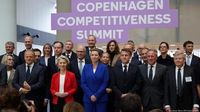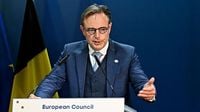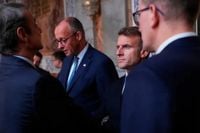European leaders are grappling with a high-stakes dilemma: how to harness hundreds of billions in frozen Russian assets to support Ukraine, all while navigating legal minefields and bracing for potential retaliation from Moscow. As the war in Ukraine grinds on, the pressure to find creative ways to finance Kyiv’s defense and reconstruction is mounting—and so are the risks.
At the heart of the debate is a bold new proposal from European Commission President Ursula von der Leyen. On October 1, 2025, von der Leyen unveiled a mechanism that would allow the European Union to offer Ukraine a massive loan—potentially worth €140 billion—backed by the interest and proceeds from Russian assets frozen in Europe since the start of the war. Crucially, the plan avoids outright confiscation: Ukraine would only be required to repay the loan if Russia pays postwar reparations. Otherwise, the assets remain frozen, and EU taxpayers are shielded from direct financial exposure.
According to Bloomberg, the EU, G7 countries, and Australia have frozen an estimated €260 billion in Russian securities and cash, with the bulk—nearly €211 billion—held within the EU. Most of these funds reside in Belgium’s Euroclear, the central securities depository, which has suddenly found itself in the international spotlight. As of June 2025, Euroclear was holding about €194 billion in Russian central bank assets, making Belgium a key player in the unfolding drama.
But the EU’s plan is far from a done deal. At a Copenhagen summit on October 2, 2025, leaders from the 27 member states voiced both support and skepticism. German Chancellor Friedrich Merz expressed cautious optimism, telling reporters, "We have had very intensive discussions on the use of Russian assets (...) We will now examine this issue very carefully again and make a final decision at the next European Council summit in three weeks." The official summit is scheduled for October 23-24, 2025, and expectations are high that a breakthrough could come then.
Yet, as Financial Times reported, EU leaders have instructed the European Commission to further study the legal and fiscal implications of using seized Russian assets. Chancellor Merz made it clear that no final decision would be made at the informal Copenhagen meeting, and that more concrete measures are expected only at the end of October at the earliest. The complexity of international law looms large, and several leaders have demanded robust guarantees before moving forward.
Belgian Prime Minister Bart De Wever, whose country is the custodian of the lion’s share of the assets, was particularly vocal. Speaking at a press conference on the sidelines of the Copenhagen summit, he insisted, "I want the maximum of legal certainty. I want solidarity. And I want transparency on the situation in the other countries. I don't think this is an unreasonable position." For Belgium, the stakes are especially high: acting without full EU backing could make it a prime target for Russian retaliation.
Russia, unsurprisingly, has condemned the EU’s intentions in the strongest terms. Kremlin spokesman Dmitry Peskov called the plan "theft," warning that the EU’s move "amounts to plans to illegally confiscate Russian property." According to AP, Moscow has threatened to respond with symmetrical measures, including the nationalization and rapid sale of foreign-owned assets in Russia. On September 30, 2025, President Vladimir Putin signed a decree allowing for an accelerated procedure to sell state property—including assets owned by foreign companies—in as little as ten days. The decree is seen as a direct response to the EU’s proposals and signals Moscow’s willingness to retaliate economically.
Hundreds of Western companies still operate in Russia, including major players like UniCredit, Raiffeisen Bank International AG, PepsiCo, and Mondelez International. The new Russian decree could put their investments at risk, as it enables the government to swiftly nationalize and auction off foreign assets. The message from the Kremlin is clear: if Europe moves to use Russian funds, Moscow won’t hesitate to hit back.
Despite the threats, many EU leaders believe the new loan scheme offers a pragmatic way forward—one that avoids the most controversial step of outright confiscation. European Commission President von der Leyen emphasized, "We are not confiscating the assets, but we are taking the cash balances for a loan to Ukraine." She added, "Ukraine has to pay back this loan if Russia pays reparations. Russia is the perpetrator. It has caused the damage, and it has to be held accountable." Von der Leyen also expressed confidence that her team had found "a sound legal way to do this" and to persuade reluctant member states.
Danish Prime Minister Mette Frederiksen echoed this sentiment, describing the plan as "actually quite a good way forward," though she acknowledged that "there are some legal questions that have to be asked and I’m confident that we will find a way through this." EU foreign policy chief Kaja Kallas was more cautious, noting, "It’s not supported by everybody yet, so there’s still a lot of work to do. But if we don’t take those assets into account then it’s on our taxpayers, that’s for sure."
There are, however, significant obstacles. The European Central Bank has warned that seizing the assets themselves could damage the credibility of the euro. France and Italy, both grappling with high debt, are wary of the financial implications, while Hungary has a track record of vetoing EU support for Ukraine. If the plan cannot be incorporated into the EU’s next long-term budget, it may have to rely on national guarantees—a prospect that makes some capitals uneasy.
Meanwhile, the financial needs on the ground are immense. Ukraine’s budget and military requirements for 2026 and 2027 are estimated at €130 billion ($153 billion), according to AP. Since the war began in February 2022, the EU has already provided €174 billion in support. The proposed €140 billion loan would represent a massive new commitment, designed to keep Ukraine afloat as U.S. financial support has dwindled under President Donald Trump’s administration.
In the background, the UK has already taken steps to use proceeds from frozen Russian assets, directing one billion pounds toward military aid for Ukraine in September 2025. The G7 countries have also pledged a $50 billion loan for Ukraine, with the U.S. contributing $20 billion. The EU’s current plan is part of this broader international effort to ensure Ukraine has the resources it needs to endure—and, ultimately, to rebuild.
With the next EU summit looming, the world is watching to see whether European leaders can bridge their differences and deliver on their ambitious promises. The outcome will not only shape Ukraine’s fate, but could also set a precedent for how international law and economic warfare are wielded in the 21st century. As the clock ticks down, the stakes could hardly be higher.


